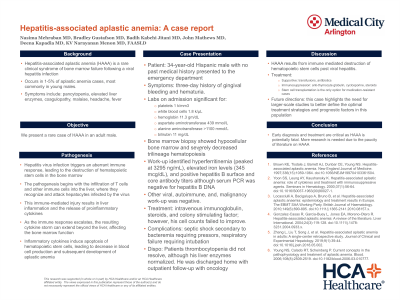Sunday Poster Session
Category: Liver
P1336 - Hepatitis-Associated Aplastic Anemia: A Case Report
Sunday, October 27, 2024
3:30 PM - 7:00 PM ET
Location: Exhibit Hall E

Has Audio

Nasima Mehraban, MD
Medical City Arlington
Denton, TX
Presenting Author(s)
Nasima Mehraban, MD1, Bradley Gustafson, MD1, Badih Kabchi Jitani, MD2, John Mathews, MD2, Deena Kapadia, MD2, KV Narayanan Menon, MD2
1Medical City Arlington, Denton, TX; 2Medical City Dallas, Dallas, TX
Introduction: Hepatitis-associated aplastic anemia (HAAA) is a rare clinical syndrome of bone marrow failure following a viral hepatitis infection. It is most common in young male children and reported in 1-5% of cases of aplastic anemia. We present a rare case of HAAA in an adult male.
Case Description/Methods: A 34-year-old Hispanic male with no past medical history presented to the emergency department with three-day history of gingival bleeding and hematuria. On admission, labs showed: platelets 1 k/mm3, white blood cells 1.8 k/µL, hemoglobin 11.3 gm/dL, aspartate aminotransferase 439 mmol/L, alanine aminotransferase >1100 mmol/L. He was jaundiced with bilirubin of 11 mg/dL. Bone marrow biopsy showed hypocellular bone marrow and severely decreased trilineage hematopoiesis. Work-up identified hyperferritinemia (peaked at 3295 ng/mL), elevated iron levels (345 mcg/dL), and positive hepatitis B surface and core antibody titers although serum PCR was negative for hepatitis B DNA; other viral, autoimmune, and, malignancy work-up was negative. He was treated with intravenous immunoglobulin, steroids, and colony stimulating factor; however, his cell counts failed to improve. He went into septic shock requiring pressor support. He subsequently developed respiratory failure and was intubated. The patient is currently extubated and off pressor support in the intensive care unit.
Discussion: HAAA is characterized by immune mediated destruction of hematopoietic stem cells following a viral hepatitis infection. Although the pathogenesis is not completely known, it is believed that the immune response after an infection leads to the activation of cytotoxic T lymphocytes which target infected hepatocytes and hematopoietic stem cells through molecular mimicry and causes release of inflammatory cytokines (interferon-gamma and tumor necrosis factors) which suppress hematopoiesis. Effective management requires early diagnosis and treatment because it is fatal if left untreated. Treatment includes supportive management with transfusions and antibiotics to manage infections, immunosuppressive therapy with anti-thymocyte globulin and cyclosporine in combination with steroids to mitigate the immune-mediated destruction of hematopoietic stem cells. For medication-resistant HAAA, the only available treatment is allogeneic stem cell transplantation. There is a paucity of literature related to HAAA, further research is warranted to better understand HAAA.
Disclosures:
Nasima Mehraban, MD1, Bradley Gustafson, MD1, Badih Kabchi Jitani, MD2, John Mathews, MD2, Deena Kapadia, MD2, KV Narayanan Menon, MD2. P1336 - Hepatitis-Associated Aplastic Anemia: A Case Report, ACG 2024 Annual Scientific Meeting Abstracts. Philadelphia, PA: American College of Gastroenterology.
1Medical City Arlington, Denton, TX; 2Medical City Dallas, Dallas, TX
Introduction: Hepatitis-associated aplastic anemia (HAAA) is a rare clinical syndrome of bone marrow failure following a viral hepatitis infection. It is most common in young male children and reported in 1-5% of cases of aplastic anemia. We present a rare case of HAAA in an adult male.
Case Description/Methods: A 34-year-old Hispanic male with no past medical history presented to the emergency department with three-day history of gingival bleeding and hematuria. On admission, labs showed: platelets 1 k/mm3, white blood cells 1.8 k/µL, hemoglobin 11.3 gm/dL, aspartate aminotransferase 439 mmol/L, alanine aminotransferase >1100 mmol/L. He was jaundiced with bilirubin of 11 mg/dL. Bone marrow biopsy showed hypocellular bone marrow and severely decreased trilineage hematopoiesis. Work-up identified hyperferritinemia (peaked at 3295 ng/mL), elevated iron levels (345 mcg/dL), and positive hepatitis B surface and core antibody titers although serum PCR was negative for hepatitis B DNA; other viral, autoimmune, and, malignancy work-up was negative. He was treated with intravenous immunoglobulin, steroids, and colony stimulating factor; however, his cell counts failed to improve. He went into septic shock requiring pressor support. He subsequently developed respiratory failure and was intubated. The patient is currently extubated and off pressor support in the intensive care unit.
Discussion: HAAA is characterized by immune mediated destruction of hematopoietic stem cells following a viral hepatitis infection. Although the pathogenesis is not completely known, it is believed that the immune response after an infection leads to the activation of cytotoxic T lymphocytes which target infected hepatocytes and hematopoietic stem cells through molecular mimicry and causes release of inflammatory cytokines (interferon-gamma and tumor necrosis factors) which suppress hematopoiesis. Effective management requires early diagnosis and treatment because it is fatal if left untreated. Treatment includes supportive management with transfusions and antibiotics to manage infections, immunosuppressive therapy with anti-thymocyte globulin and cyclosporine in combination with steroids to mitigate the immune-mediated destruction of hematopoietic stem cells. For medication-resistant HAAA, the only available treatment is allogeneic stem cell transplantation. There is a paucity of literature related to HAAA, further research is warranted to better understand HAAA.
Disclosures:
Nasima Mehraban indicated no relevant financial relationships.
Bradley Gustafson indicated no relevant financial relationships.
Badih Kabchi Jitani indicated no relevant financial relationships.
John Mathews indicated no relevant financial relationships.
Deena Kapadia indicated no relevant financial relationships.
KV Narayanan Menon indicated no relevant financial relationships.
Nasima Mehraban, MD1, Bradley Gustafson, MD1, Badih Kabchi Jitani, MD2, John Mathews, MD2, Deena Kapadia, MD2, KV Narayanan Menon, MD2. P1336 - Hepatitis-Associated Aplastic Anemia: A Case Report, ACG 2024 Annual Scientific Meeting Abstracts. Philadelphia, PA: American College of Gastroenterology.
